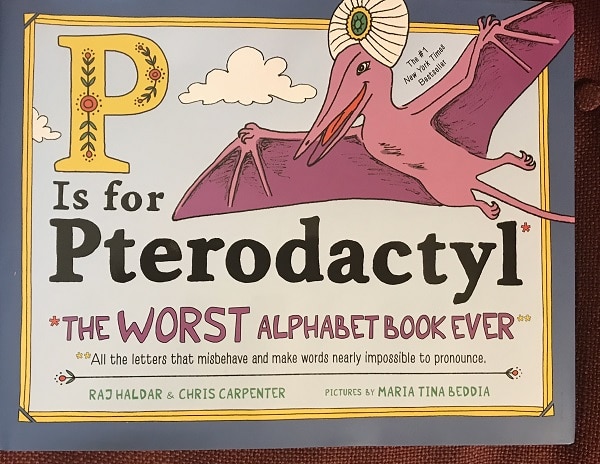Emma, this book review is for you, but don’t tell your Mom and Dad. They’d probably get all worried that a book like P is for Pterodactyl will ruin your spelling.
I mean, really!
You know — or, at least, you will very soon — that when you see a “p” at the start of a word, the word, most of the time, will have a “p” sound there, like pig and pistachio and punctilious.
But then there are words such as pterodactyl.
I never thought of this before, but Raj Haldar and Chris Carpenter, who wrote this book, showed me that pterodactyl is pronounced the way it is because the “p” is silent.
The silents…and others
In fact, a lot of the words they highlight in their book, playfully illustrated by Maria Tina Beddia, have silent letters, such as:
- C is for czar.
- G is for gnocchi.
- M is for mnemonic.
- W is for wren.
“M” and “w” are pretty straight-forward in their sounds, except when they’re silent.
But you know — or, at least, you will very soon — that “c” often will sound like “k” in cook, but sometimes it’ll sound like an “s” in circle.
And that “g” will sound like “g” in get, but it can also sound like the “g” in geology, or like the “g” in genre.

Quinoa and quay
As you’re likely to guess, a lot of the silent-letter words come from a non-English language, such as gnocchi. Other foreign words don’t have silent first letters but have become entrenched in English, such as jai alai, oui and quinoa — HIGH-lie, wee and KEEN-wah.
KEEN-wah? I’m like a thousand years old, but it wasn’t until I read this book that I realized the words I said in my head as “quin-oa” is actually said “KEEN-wah.”
It’s not the only one. I also learned, at this late date, from this book, how to pronounce Oaxaca (wa-HA-ka), Qatar (CUT-er) and quay (key).
Quay isn’t pronounced “kway”???? Wow, what I learned from this book!
Are and our
Seven of Haldar and Carpenter’s chapters have to do with another kind of letter, a letter that isn’t used for a word that sounds like it, such as:
- F is not for photo (except in Spanish in which the word is spelled foto).
- I is not for eye.
- L is not for Elle.
- N is not for knot.
- R is not for are.
- U is not for you. (But E is for ewe.)
- Y is not for why.
When I was a little kid, I thought that are and our were pronounced the same way. What a ninny I was, right? Eventually, I figured out that our didn’t sound like are, but it did sound like hour.
Some of the words in this book don’t fit into any other categories and seem almost subversive. Such as E for ewe. Or S for seas (which you’d think would be spelled cees, right?).
The fun of using English
All of this hints at how much fun it is to learn and use English.
The pronunciation of English words, for the most part, came about before somebody sat down to figure out the rules of pronunciation. So, some words, such as wren, are very old and somehow avoided being forced to operate within the rules. Often, that means there’s a story behind the word. I don’t know what the story of wren is, but I’m sure there is one.
Every word has a story, and dictionaries, especially some of the more scholarly ones, tell the story of each.
English is cool. Dictionaries are cool. And this book is cool, too.
You’re going to have fun reading it.
Soon.
Patrick T. Reardon
12.11.19
Written by : Patrick T. Reardon
For more than three decades Patrick T. Reardon was an urban affairs writer, a feature writer, a columnist, and an editor for the Chicago Tribune. In 2000 he was one of a team of 50 staff members who won a Pulitzer Prize for explanatory reporting. Now a freelance writer and poet, he has contributed chapters to several books and is the author of Faith Stripped to Its Essence. His website is https://patricktreardon.com/.
